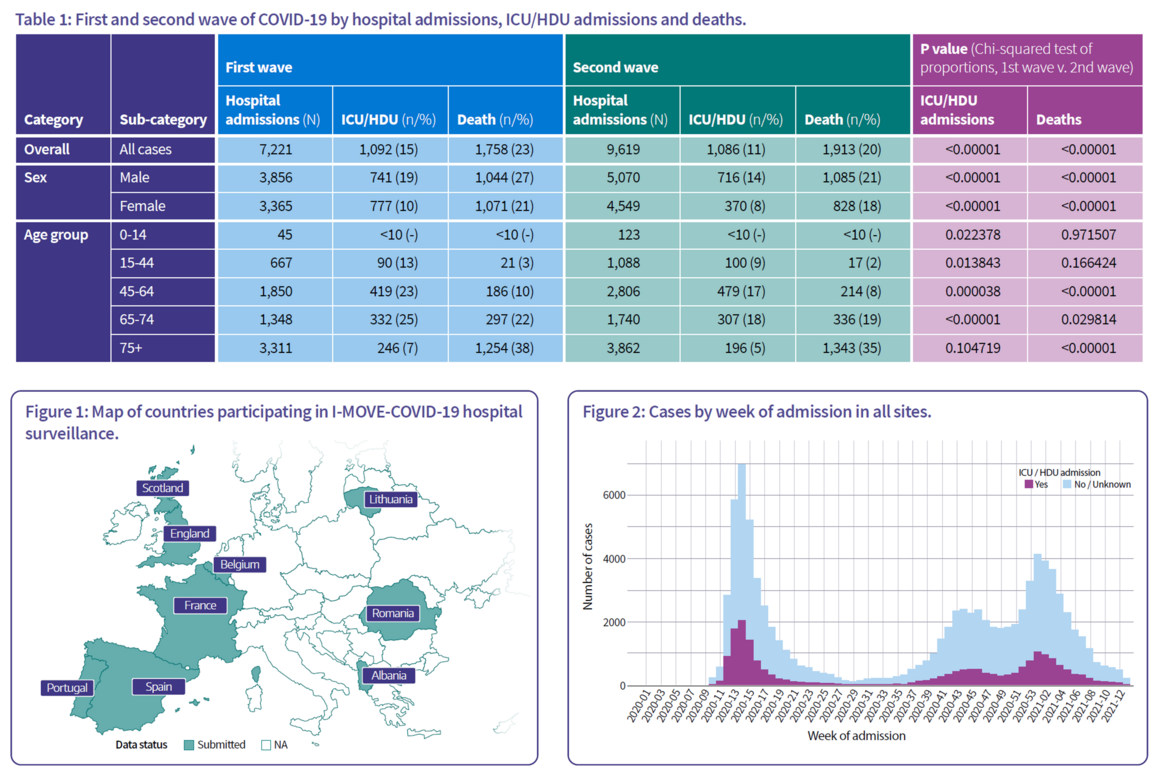Interview with Heather Mutch
Heather Mutch was the presenter of the winner for best poster at ESCAIDE 2021, Enhanced surveillance of COVID-19 in secondary care in Europe: a tale of two waves.
We asked Heather some questions about the team behind the poster and their work.
Tell us about you and the team who conducted the research.
The analysis included in this poster was conducted by the Respiratory Secondary Care Surveillance team at Public Health Scotland as part of the I-MOVE-COVID-19 hospital surveillance study. This research involved the I-MOVE-COVID-19 hospital surveillance network. Data was collected from 11 different sites in nine countries spread across the European Union and European Economic Area; Albania, Belgium, England, France (2 sites), Lithuania, Portugal, Romania, Scotland and Spain (2 sites). Data collection was coordinated by Epiconcept, who received the data, carried out checks and cleaned the data and then amalgamated each sites submission into a pooled European dataset. The pooled dataset was then sent to the Respiratory Secondary Care team at Public Health Scotland who analysed the data and produced regular bulletins with support from Epiconcept. This work required a huge amount from effort across each of the sites and co-ordinators involved and I feel privileged to have been a part of it.
How did this study come about? What are the main insights from the study, and the wider I-MOVE-COVID-19 Consortium work, and how can they be applied in practice?
The I-MOVE-COVID-19 study was implemented due to the emergence of the COVID-19 pandemic. Its main aims were to study the epidemiological and clinical characteristics of those hospitalised as a result of the disease, as well as the virological characteristics of SARS-CoV-2 in hospitalised patients in order to add to the pooled knowledge surrounding the disease and help to inform the public health response. This was carried out by implementing surveillance systems of those hospitalised with suspected, probable and confirmed cases of COVID-19, the data was then analysed and disseminated in quarterly surveillance bulletins.

What were the challenges you faced while conducting this research?
The I-MOVE-COVID-19 hospital surveillance network faced numerous challenges whilst conducting this study ranging from data and infrastructure issues, timeliness and sustainability all whilst being set up during a pandemic. Information governance and data quality were a challenge from the inception of the study which made it difficult to report on all surveillance variables of interest. Trying to give timely descriptive analysis was another hurdle due to delays in diagnosis and reporting as well as resourcing within teams. In addition to this, the fact that this was carried out during a pandemic meant that funding and resources for the research were subject to ad-hoc pandemic grants.
Despite all these challenges the project was a success. The different sites involved were able to establish novel surveillance systems, discuss any problems which they faced and shared learning to overcome these by participating in this research. The study was also able to provide a wealth of information surrounding the behavior of COVID-19 within hospitalised patients across Europe.
Is there any aspect of the study that there was not time to discuss in more detail that you would like to highlight here?
During the poster presentation there was a real emphasis on the differences between the two regions of peaked hospital activity. For additional analysis which was carried out, including breakdown of patient demographics or the symptoms which were presented, I would refer anyone to the I-MOVE website (I-MOVE-COVID-19 publications | IMove (imoveflu.org)) where the bulletins have been published and anyone who is interested can read through these at their leisure. In addition to this, a risk factor study based on these patients is being prepared which will explore an array of topics such as, any chronic conditions experienced by those hospitalised with the disease.
Has this surveillance project been continued since the “second wave”? What do you plan to do going forwards?
The surveillance project is currently still ongoing with an ending date of March 2022. We will publish our final surveillance report around this time which will cover the overall behaviour of the disease within hospitalised patients and look at trends to establish how this has changed over time. We are also in the process of carrying out an evaluation of this European COVID-19 hospital surveillance system, to assess several attributes of the surveillance system. This is a mixed methods evaluation using an online survey distributed among all the sites, in-person discussions and quantitative methodology to determine the strengths of the system and challenges faced during the project. This evaluation will allow recommendations which will allow the COVID-19 hospital surveillance system to be further strengthened.
This project has received funding from the European Union’s Horizon 2020 research and innovation programme under grant agreement No 101003673. We would also like to acknowledge the continuing contributions of everyone involved within the I-MOVE-COVID-19 hospital surveillance network.
